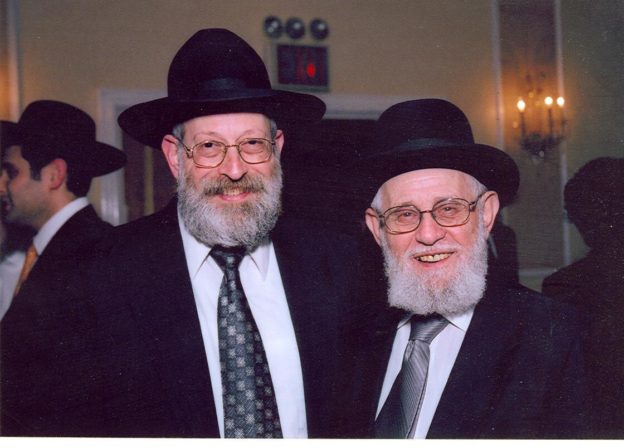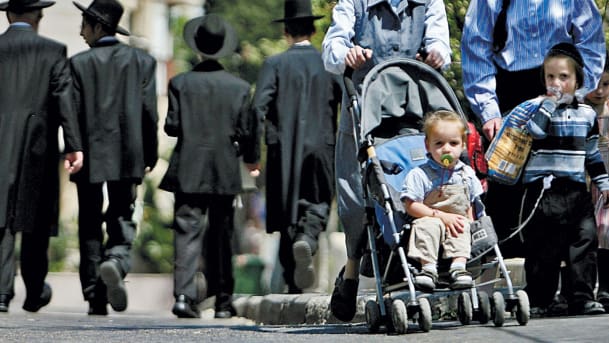A piece I wrote about my father, a”h, and one of many life lessons he taught me was published by Fox News today. It can be accessed here.


A piece I wrote about my father, a”h, and one of many life lessons he taught me was published by Fox News today. It can be accessed here.

As sad as it is ironic, those who have seized the opportunity during protests over the killing of George Floyd to vandalize police vehicles and attack officers, deface buildings and loot stores are perpetuating racism.
Because, by their actions, they effectively reinforce the prejudices of people who view people of color as unbridled and lawless. Instead of images of black or brown scientists, doctors, lawyers, teachers or social workers, what the face of a nonwhite person conjures in their minds is a threat.
That’s what was perceived by the white woman who was firmly perched at the precipice of the news cycle until the killing of Mr. Floyd pushed her off. A black man who was bird-watching in New York’s Central Park politely asked her to restrain her unleashed dog and she responded by calling police, claiming that an “African-American” was threatening her. His words “Look, if you’re going to do what you want, I’m going to do what I want, but you’re not going to like it” probably wouldn’t have struck her as threatening had the bird watcher been Caucasian.
But he wasn’t and so they did.
And the looters of late have only empowered such prejudice. Of, course, thugs don’t give a first, much less second, thought to the impact of their actions on others. Their only concern is about what good stuff they might grab from violated stores. How unfortunate, though, that the national conversations about racial injustice and police misconduct have again been marred by mindless marauders.
As it happens, it wasn’t only on American streets that roguery reigned. As always these days, when chaos and stupidity blossom, the noxious pollen of Jew-hatred is released across the internet, particularly on social media.
And so it is that we have, on Twitter, a man (whose identifying graphic is a Hebrew declaration of fealty to Christianity) proclaiming that “Jewish whites were the most prolific slave owners in history. They practically created slavery in America,” and concluding that shuls are “free game” for vandalism.
Aside from his hogwash “history,” his conclusion is, to put it delicately, illogical. It takes a twisted mind to invoke something that didn’t happen in order to vilify distant descendants of those who didn’t do it.
There was further lunatic logic, too, from another Twitter twit, who explained that “Jewish Americans hold all the power in the country, thus you cannot be racist or anti-Semitic towards them.”
So, you see, since many Jews have been successful in their professions, in the public sphere and in public service, hatred and harm can be directed against them.
Interestingly, falsehoods propagated by social media became a recent major news item, too, right alongside the killing of George Floyd and its aftermath.
Twitter took the unprecedented step of placing a fact-check notice on a tweet by President Trump in which he asserted that mail-in ballots lead to voter fraud. The notice directed followers of the president’s tweets to a site offering facts showing otherwise.
And then, a day later, the social media company put a warning label on what it regarded as the president’s threat against protestors in Minneapolis, his tweet that “when the looting starts, the shooting starts” — a sentence that has been used by racists in the past and that, Twitter said, “violates our policies regarding the glorification of violence [because of the sentence’s]… historical context… its connection to violence, and the risk it could inspire similar actions today.”
In response, Mr. Trump accused Twitter of bias against him, and issued an executive order aimed at removing Section 230 of the Communications Decency Act, a move could change the status of social media giants from “platforms,” which absolves them of responsibility for things posted on them, to the equivalent of newspapers, leaving them open to lawsuits over anyone’s postings.
Although it’s safe to say that it wasn’t Mr. Trump’s intent, removing Section 230 would likely force the social media giants to disallow him to post on them — entailing a loss of eyeballs they will be anguished to suffer — and open the door for decentralized, under-the-radar alternatives to take their place. Some of those alternatives will be more than happy to host the president.
And they will be happy, too, to host people seeking to destabilize society. The Wall Street Journal recently reported that Facebook hid a study it undertook that found that its algorithms exacerbate polarization — that 64% of all extremist group ‘joins’ produced by the platform “are due to our recommendation tools.”
And so, if Twitter’s attempts to correct misinformation is effectively undermined, we can expect a slew of new “post what you will” platforms that will become newly popular and eagerly employed by the always-ready-to-pounce anti-Semites on the extremes of the political spectrum.
Such actors will be itching to spread canards about Jews and to encourage violence against them. As itching as amoral rioters are to steal sneakers and luxury goods.
© 2020 Rabbi Avi Shafran

An article I wrote about the media’s obsession with Haredim who flout norms, and what it shows — about the media, not Haredim — is here.

It’s been some 700 years since the bubonic plague ravaged central Asia, killing millions of people. A decade or two later, in October, 1347, a ship from the Crimea docked in Messina, Sicily. Rats in its hold were infested with fleas that harbored the bacterium that causes the sickness.
That marked the beginning of the era known as the Black Death. Over the next 50 years, it is estimated that at least 25 million people died, between 25% and 60% of the continent’s population.
Yes, that disaster is recalled here because of the coronavirus, or Covid-19, currently spreading around the world. Not, though, in order to raise great alarm, because, at least at this point, it is not warranted. Rather to note, firstly, the stark contrasts between the bubonic plague and the current viral outbreak; secondly, to remind readers of the Jewish angle of the Black Death years; and, thirdly, to convey a lesson from that plague to the current medical challenge.
The contrast lies in several things. For starters, no one at the time of the Black Plague had any idea of what was causing it. At a time of deep ignorance, fueled by Christian lore and superstition, all sorts of theories abounded, none of which did anything to slow the disease. Today, we know what is causing the current pandemic, and, hopefully, modern science can develop the means of protecting the vulnerable from the Covid19 virus’ worst effects.
And, unlike the bubonic plague, baruch Hashem, Covid-19 does not harm the vast majority of those who contract it. It is particularly dangerous to the elderly and infirm, and to smokers and others with less than optimum lung function. But to most people not in any of those categories, the infection results in either no symptoms at all or in flu-like experiences – fever, cough and headache.
Finally, as the eminent and wonderfully readable late historian Barbara Tuchman recounted in her book A Distant Mirror, the Middle Ages plague brought people to turn on one another rather than work together to deal with the challenge.
Christian religious leaders abandoned their flocks, parents deserted children; and children, their parents. “Charity,” she wrote, “was dead.”
Today, nations and scientists and health workers are working hard to educate people about the current virus, to create a vaccine against it and to find the most effective therapies for the stricken, if not an actual cure. People might be quarantined, for their or others’ benefit, but no one is being deserted.
The Jewish angle to the Black Death was the pointing (as usual) of fingers of blame at our forebears.
The plague, it was widely declared, was punishment for Christian society’s allowing Jews to live in their midst as Jews. Although Jews, too, perished in the plague, only in much smaller numbers, it was said. The resulting “logic” had it that ending the epidemic lay in converting, exiling or murdering Jews. Despite the declarations of several popes that the Jews were not at fault for the plague, people on the street were sure they knew better.
Then the populace came up with a better reason to blame Jews – the stubborn rejecters of Christianity were poisoning the drinking wells of communities, the better to harm Christians. Some Jews even confessed to such crimes – after being forced to do so in order to end their horrific torture.
On February 14, 1349, a day on which Christians venerate a third-century clergyman named Valentine, a contemporary observer of events recorded, some 2000 Jews were forced onto a wooden platform in the Holy Roman Empire city of Strasbourg’s Jewish cemetery and burned to death. Parents held tightly to their children when citizens tried to take them away for baptism.
The Jewish communities in Antwerp and Brussels were entirely exterminated in 1350. From 1349 until about 1390, the Jewish communities of France and Germany were decimated by angry mobs. In 1350, Frankfurt had over 19,000 Jews. By 1400, not a minyan was left.
Historians tend to take seriously the contention that Jewish communities were less affected by the plague itself, if not from the hatred it unleashed. And that brings us to the lesson to be learned from events seven centuries in the past.
The ostensible reason that the Black Death may have affected Jews to a lesser degree than Christians lies, the historical consensus has it, in the fact that Jews frequently wash their hands.
Upon arising in the morning, before tefillos, before saying Asher Yatzar, before bread meals (which were most, if not all, meals over most of history), Jews poured water over their hands. And, what’s more, they bathed – a luxury back in the Middle Ages – every week in honor of Shabbos.
We Jews still wash our hands a lot. But today most of us live in environments where every doorknob, subway pole and bus passenger is a vector for the transmission of germs.
Although it is likely that the spread of Covid-19 will intensify before it, b’ezras Hashem, soon, abates, we would do well, especially the elderly and health-compromised among us, to do the equivalent of netilas yadayim through the day, ideally, thoroughly and with soap.
That will not only help protect us from the current and other infections, but be a worthy reminder of the mesirus nefesh of, and kiddush Hashem created by, our ancestors in Europe.
© 2020 Hamodia

A piece I wrote about the marginalization of Haredi Jews appears at the New York Times today. It can be read here.

For some of us, double-edged swords don’t come more dangerous than the prospect of a Jewish president. The accomplishment would be heartening in a way, and would say much about America. But the reality of a Jewish person sitting in the White House would not please people infected with the derangement we call anti-Semitism. And we have more than enough of that as is, thank you.
To be sure, unless the current Commander-in-Chief is removed from office (not likely) or the Electoral College is abolished (less likely), the race for the Democratic candidacy will probably prove to be only a contest to determine who will be defeated by President Trump in November.
Still, it is noteworthy – and fear-worthy, for the above-mentioned some of us – that, back in the 1950s, two currently viable viers for the highest office in the land celebrated bar mitzvahs.
Both are ex-mayors: Senator Bernie Sanders, of Burlington, Vermont; and Michael Bloomberg, of New York. The former is a populist progressive backed by a strong grass-roots movement; the latter, a savvy, successful businessman backed by an impressive record and the willingness to spend a billion dollars of his own money on his campaign.
And both are touting their tribal credentials, to appeal to Jewish voters.
“I’ve spent a lot of time in synagogues in my life,” Mr. Bloomberg told a packed Jewish venue in Miami last week, “but my parents taught me that Judaism is more than just going to shul. It is about living our values… and it’s about revering the miracle that is the state of Israel, which – for their generation – was a dream fulfilled before their very eyes.”
In oblique criticism of Senator Sanders’ democratic socialism, he joked that “I know I’m not the only Jewish candidate running for president. But I am the only one who doesn’t want to turn America into a kibbutz.”
Continuing his bombing of Bernie, who has indicated he might withhold military aid from Israel if it didn’t better address humanitarian needs of Gazans, Mr. Bloomberg pledged to “never impose conditions on our military aid [to Israel], including missile defense – no matter who is Prime Minister.”
And, of course, after speaking at length about recent acts of violent anti-Semitism, he attacked Mr. Trump, associating him obliquely, and unfairly, with “racist groups” that “spread hate.”
“A world in which a president traffics in conspiracy theories,” he went on to declare, “is a world in which Jews are not safe.”
For its part, the Sanders campaign rolled out its own Jewy video last week, which began with a clip of the senator, at a J Street gathering last year, proclaiming that “I’m very proud to be Jewish, and look forward to becoming the first Jewish president in the history of this country.”
At that gathering, Mr. Sanders declared: “If there is any people on Earth who understands the dangers of racism and white nationalism, it is certainly the Jewish people.” And, in his own swipe at the president, he added: “And if there is any people on earth who should do everything humanly possible to fight against Trump’s efforts to try to divide us up… and bring people together around a common and progressive agenda, it is the Jewish people.”
And, although he accuses the current Israeli government of unfairness to Palestinians, he calls himself “somebody who is 100 percent pro-Israel.”
Fighting anti-Semitism and declaring support for Israel may please many Jewish political palates, and, b”H, remain pretty much de rigueur positions for any serious presidential candidate.
But office contenders seeking Jewish votes these days would be wise to not ignore American Jewry’s Orthodox segment. It may be a fraction of the country’s Jewish population (around 10%, it’s estimated) but it is a fraction that, according to sociologist Steven M. Cohen, has more than quintupled over the past two generations, and stands, b’ezras Hashem, to continue its growth.
According to the Pew Research Center, more than a quarter of American Jews 17 years of age or younger are Orthodox. Public policy experts Eric Cohen and Aylana Meisel have estimated that, by 2050, the American Jewish community will be majority Orthodox.
We Orthodox, like most other Jews, are greatly concerned about Israel’s security and about rising anti-Semitism. But, in addition to those issues, a major item on our political agenda is education.
We believe in school choice – that parents are the best arbiters of what schools their children should attend, and should not be financially penalized for not choosing public schools. And we consider it critically important that government involvement in determining the content of curricula in private schools be minimal.
Senator Sanders is officially on what we consider the wrong side of both those issues. Mr. Bloomberg, while he has long been a proponent of educational choice with regard to things like public charter schools, hasn’t taken a public position on either of our own educational concerns.
It’s not too late for him to do so, of course, and, as someone who fundamentally understands the importance of educational options, he might come to see the sense and fairness in our positions.
From a political perspective, it would be wise.
More important, though, from a Jewish perspective, it would be right.
© 2020 Hamodia

Security for Jewish institutions – shuls, schools, community centers and organizations – has understandably been at the forefront of many minds and agendas in recent months. Agudath Israel of America, where I serve as public affairs director, has been instrumental in securing considerable federal and state funds to help protect places where Jews gather.
I remind readers that I write in this space only as an individual, not in my organizational role. In that role, though, I’ve fielded a number of inquiries from the media and public about the security issue. Two recent ones stand out, because they made me think – something that, while not always easy, is highly recommended.
The first communication was from an irate gentleman who wanted to know why, if the Agudah has in fact helped secure security funding for schools like the one his children attend, he was being asked by the school to contribute to a parents’ fund to upgrade the institution’s safety, presumably for yet additional security measures. I suggested to him that his question, a reasonable one, would best be directed to the school administration.
The second was from a rightly respected mechaneches whom I’ve known for many years and who just wanted to sound out my opinion about whether certain safety concerns or actions, like some being considered by her children’s basically secured school, might be going a bit overboard.
As I say, the two questions made me think, about the fundamental Jewish concept called bitachon.
“Trust,” is how the word is usually translated, but, of course, it means something both more subtle and more weighty. It means keen recognition of the fact that, while we are enjoined to make normative efforts to earn our livings, raise our children and accomplish our goals in life – including protecting ourselves from potential harm – ultimately, it is not our actions that yield us any success we experience, but rather the will of Hashem.
Consider a thought experiment: A shul, worried by recent acts of violence against Jews, hired an armed guard to stand at its entrance, and a would-be intruder with a weapon is thwarted by the alert and quick sentry. Needless to say, the fellow deserves the congregation’s thanks. And hiring him may have been the right thing to do, part of the proper hishtadlus – human effort – to be made these days.
But what in fact saved the mispallelim?
Hint: The answer isn’t “the guard.”
Hiring the man, assuming it was a necessary part of hishtadlus, may have been part of the collective merit that brought about the happy ending, or the attack’s failure may have been merited by other good deeds. But what protected the shulgoers was not, in the end, any mortal guard, but the Guardian of Yisrael.
Recognizing – internalizing – that Jewish truth is imperative. In fact, it is essential to our safety.
Rav Dessler (Michtav MeEliyahu, first chelek, page 188, in the original edition) cites the common expression “We’ve left nothing to chance” and calls it a contemporary version of the boast “My strength and the might of my hand has created this victory for me” (Devarim, 8:17).
He calls the “leave nothing to chance” attitude one “of conceit, apikorsus and idolatry.” And he asks all who consider themselves maaminim to consider if, perhaps, “even in their own hearts” there might dwell some residue of such kefirah (his word).
Can we even think that an armed guard is a true protection against an intruder? Can’t a clever terrorist plan, chalilah, to shoot a guard from an unseen perch before proceeding with his nefarious aim? A pair of guards might be hired, to avoid that possibility. But what if there are two terrorists acting in tandem, one for taking out each of the guards? As the Gemara says in a different context, ein l’davar sof, “there’s no end” – here, to the security “arms race.”
Most of us would readily concede that hiring a small militia to surround a shul and arranging for police helicopters to hover constantly overhead would be an unreasonable choice, a misunderstanding of hishtadlus and an insult to bitachon.
And most of us would consider, at least in our day, locks on a large shul’s doors to be prudent. When it comes, though, to armed guards – and certainly armed congregants – or to bulletproof glass or to evacuation drills, things are not necessarily so simple. More, here, is not better; in fact, as per Rav Dessler, it’s worse.
Properly balancing bitachon and hishtadlus is a complex venture, one best left to poskim and manhigim with the Torah knowledge, experience and sensitivity to guide us.
But hitting the right such balance, which may, of course, yield different decisions in different times and in different places, is vitally important.
Because not only is tilting too far in the direction of bitachon dangerous, so is tilting too far in the direction of hishtadlus. And, in the end, balancing the two properly is what truly ensures our safety.
© 2020 Hamodia

a piece I wrote for the Jewish Telegraphic Agency, an international wire service, about the dovetailing of anti-Orthodox sentiment and violence against visibly observant Jews can be read here.

“BLACKS NEED TO RESPECT JEWISH AUTHORITY,” reads the stark, all-caps message on Telegram, an instant messaging service. The word “JEWISH” is reverse-color emphasized.
The message came from a fake account, like similar racist sentiments from similarly nonexistent “Jewish” users that flooded the social media giant Twitter a few months back.
A tweet, for example, from the fictional “Elaine Goldschmidt” who, “frightened by the string of anti-Semitic attacks,” bemoaned the fact that blacks (the tweet uses a much-reviled slur) “were supposed to be on our side. Now we have lost control of them.” The photo used in the profile was lifted from the account of a Scottish woman, Janey Godley, who, when she found out, was not pleased.
The tweet garnered hundreds of “retweets” and “likes,” including one, ostensibly from the unsubtly named, fictional “Ari Shekelburg,” who addresses “Fellow Chosen Ones…”
Welcome to 2020.
When first notified of the misleading and inflammatory messages, Twitter responded that “we didn’t find a violation of our rules in the content.” Soon afterward, though, the company reconsidered, and suspended the disingenuous account.
The social media incendiary devices above are samples of the work of white supremacists seeking to intensify anti-Jewish feeling in parts of the black community, and to sow the same among more educated blacks who may currently harbor no hatred for Jews. As one anonymous message on a site associated with white racists observed about one anti-black canard maliciously attributed to a Jew, “Posting this on black twitter would definitely stir the hornets [sic] nest.”
The bad players play both sides of the game, too, sharing concocted anti-Semitic sentiments by African-Americans or presenting actual ones as more representative of blacks than they truly are.
What apparently inspired the trolls was the fact that, while the Pittsburgh and Poway killers were white, more recent attacks on Jews, like the murders of Jews by a black couple in Jersey City, the attempted murder of Jews in Monsey last month and the obnoxious actions of some Brooklyn goons, were perpetrated by African-Americans.
What an opportunity, the race-baiters realized, to stoke the embers of hatred, to “divide and conquer” the two groups they most despise, Jews and blacks.
They mustn’t be allowed to succeed.
It was heartening and surprising to read of how Al Sharpton condemned the recent attacks on Jews, saying he was “terribly disturbed” by them, “particularly because they were perpetrated by members of the African-American community.” Mr. Sharpton, of course, was accused, and not without reason, of employing bombastic rhetoric that helped fuel the 1991 Crown Heights riots, in which 29-year-old Yankel Rosenbaum was surrounded by a large group of young black men and fatally stabbed.
Also heartening, and not surprising, were the words of Bernice King, the daughter of Rev. Martin Luther King Jr. and chief executive of the nonprofit King Center, who described the Monsey attack as an assault “against a people and a promise.” She tweeted that she was “praying for our Jewish family members” and encouraged “us all to refuse to adjust to anti-Semitic stereotypes and to rhetoric/language that dehumanizes,”
“We can’t pretend,” she concluded, “that hate is dormant.”
Radio host Larry Elder, also African-American, decried the fact that African-Americans are constantly being told that Jews are becoming wealthy by exploiting them, and asserted that “all this anti-Semitism coming from the black community against the Jewish community” shows “ignorance [of] the role many Jews played in the civil rights movement and as freedom-fighters.”
It might be futile to hope that black leaders’ exhortations will be able to cure the sort of cluelessness leavened with animosity toward “the other” that infects urban youths like the Brooklyn hoodlums who amuse themselves by harassing innocent Jews. Unfortunately, the diametric, odious messaging of rabble rousers like Louis Farrakhan strikes a more resonant chord in the imaginations of witless belligerents.
There will always be demagogues, Hitler wannabes like the “Nation of Islam” leader, and they will always manage to attract those whose aptitudes for critical thinking are no match for their susceptibilities to mental poison.
But one thing we can, and should, do is not let those vile actors and their gullible followers become the image in our minds of the larger African-American community.
If we do, we only play into the hands of our, and its, worst enemies.
© 2020 Hamodia

Direct physical attacks on Jews have, and for good reason, unfortunately, dominated the news in recent weeks. But there have been other kinds of attacks on innocent people who are perceived to be Jewish. Like the one committed against Kurt Eichenwald.
Mr. Eichenwald is an award-winning journalist who has written for the New York Times, Newsweek and other major media, and is the author as well of several books. He is also an epileptic, something he has compellingly addressed in some of his writings. And he has been critical of President Trump. Those last two facts dovetailed, regrettably, in a bad way.
After writing in 2016 about what he considered looming improper conflicts of interest in the then-president elect’s international business affairs, the Dallas-based Mr. Eichenwald experienced a flood of online vitriol and threats from people who felt that his criticism of Mr. Trump merited such reaction. It wasn’t the first time he had experienced such internet “trolling.” But spleen venting, while always ugly, is usually harmless.
It wasn’t, though, on the evening of December 15, 2016. One of Mr. Eichenwald’s less constrained critics, using “@jew goldstein” as a moniker and aware of Mr. Eichenwald’s medical condition, sent the writer an electronic graphics interchange format file (or GIF), an animated image. GIFs are usually intended to amuse, but this one, which loaded automatically, had a less benign objective.
The GIF, whose sender added his judgment that Mr. Eichenwald “deserved a seizure,” consisted of a series of bright flashes in quick succession, something that is known to trigger epileptic attacks in those, like Mr. Eichenwald, who are vulnerable to them.
The alleged culprit is one John Rayne Rivello, a Marine Corps veteran from Salisbury, Maryland. A search warrant turned up an internet account he maintained that featured, among other things, a screenshot of a Wikipedia page for his alleged victim, which had been altered to show a fake obituary with the date of Mr. Eichenwald’s death listed as Dec. 16, 2016.
Investigators also found that Mr. Rivello had sent a message to likeminded friends, outlining his plans and stating “I hope this sends him into a seizure” and “let’s see if he dies.”
Mr. Eichenwald didn’t die that day, but the previous evening, when he received the GIF, “he slumped over in his chair,” according to his attorney, Steven Lieberman. “He was unresponsive, and he probably would have died but for the fact that his wife heard a noise – she’s a physician – and she pulled him away from the screen and got him onto the floor.”
Mrs. Eichenwald called 911, took a picture of the strobing light on her husband’s computer and called the police.
Mr. Rivello was originally charged in Maryland for “assault with a deadly weapon” and, briefly, by the Northern District of Texas, under a federal cyberstalking statute.
First Amendment concerns were raised about the possibility that Mr. Rivello was being improperly targeted just for being a bigoted dimwit, which isn’t itself illegal. So the cyberstalking charge was dropped and he was re-indicted in Texas on lesser assault charges.
Mr. Rivello and his lawyer are reportedly still planning on mounting a defense on First Amendment grounds.
That claim is, or should be, easily rejected. The fact that the harm he inflicted was an expression of a political position is no more a defense of the assault than it would be had he punched Mr. Eichenwald in the face. The punch may communicate a message, but it isn’t protected by the First Amendment.
The larger, and novel, question is: Can an “assault” be committed at a distance?
From a Torah perspective, it most certainly can. It isn’t mere rhetoric or poetic license when Chazal refer to things like lashon hara or publicly embarrassing someone as damaging, even killing. Assault needn’t leave any physical trace at all. Such non-contact assaults aren’t halachically actionable, but they are considered criminal all the same.
Damage inflicted on a person by fire, though, even when the fire resulted from negligence – all the more so when set maliciously – is indeed actionable (see Mishneh Torah, Hilchos Nizkei Mammon 14:15). I don’t profess to be a posek, but it certainly seems at the very least arguable that sending an electronic signal may constitute something analogous.
In any event, Mr. Rivello’s case will of course be adjudicated by American, not Jewish, law.
It has been clear for some time now that contemporary secular law needs to evolve to meet challenges posed by new technologies like the internet.
Mr. Rivello’s next hearing is scheduled for January 31. Unless he decides to just plead guilty, his case might prove a good opportunity to rein in some cyberspace miscreancy.
© 2020 Hamodia (in an edited form)